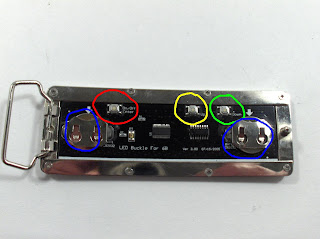LED BELT BUCKLE

The picture above is of the faceplate (the part everyone is going to see when you wear it). The rough dimensions are 13.5cm x 4.7 cm x 0.5cm not including the little buckle off to the right or the extensions on the back due to the batteries.
The device requires 2 CR2032 Batteries (the big skinny ones you find in calculators or motherboards) however I accidentally bought the 2025's, however it still works fine.

Mass of device + 2 batteries =
The device is programmable and when I first turned it on I found (to my dismay) scrolling hearts appear on the screen. A video of this can be found here:
LED BELT BUCKLE VIDEO LINK
On the back of the device is the circuit board with the battery inserts and the controls (this part is not fancy because technically no one sees it). There are 3 buttons and two battery inserts as shown below.


On the circuit board it says that the buckle can store 6B of data. Once the device is turned on you press the "Down" button once to enter the settings mode. There are several settings you can explore and change:
1. Select - This option allows you to choose between 1 of the 8 stored messages (thats right, the device can store not 1, but 8 individual messages).
2. Input - This option allows you to change any of the 8 stored messages, the device comes programmed with the entire alphabet, numbers 0-9, and several misc. symbols. You simply press the "Up" or "Down" buttons to scroll through your choices, when you are satisfied with a certain character you hold down the "Enter" button and then press the "Up" button to move onto the next character.
3. Speed - This option allows you to choose the speed of the scrolling characters across the screen, there are 8 different speeds with 8 being the fastest and 1 the slowest.
4. Left - This option causes the displayed message to scroll from right to left.
5. Right - This option causes the displayed message to scroll from left to right.
6. Up - This option causes the displayed message to scroll from bottom to top.
7. Down - This option causes the displayed message to scroll from top to bottom.
8. Freeze - This option causes the displayed message to freeze at a specific spot and not move.
9. Flash - This option causes the displayed message to flash as it moves across the screen.
10. Loop - This options causes the device to display all 8 messages one after the other and then repeat.
Last but not least, the device has 3 brightness options that you must scroll through to turn the device off. Once the device is turned on, the "high" setting of brightness is selected by default, by pressing "Off" once, the brightness is decreased to "medium", by pressing "Off" yet again the brightness is reduced to "low" and finally by pressing "Off" again, the device is turned off.
Conclusion: For roughly $30 US this device packs in more than I expected. I am quite impressed by the degree of control one is given over the settings, allowing the user to customize to their needs. Definitely a "must-have" if you want to impress the ladies and be a geek at the same time.







